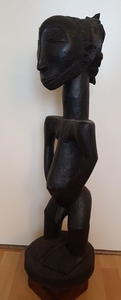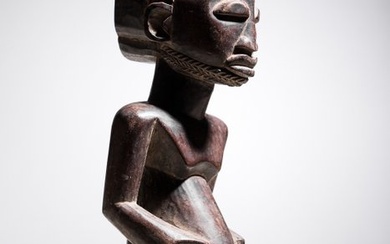Ancestor statue (1) - Wood - Hemba - Hemba - DR Congo
Hemba-Niembo Statue of the Ancestor 78 cm. In the plains of the eastern Congo, the Hemba people live in the land which extends to the north and south of the Luika River, bounded to the west by the Lualaba, the greatest head-stream of the Congo River. Their villages were “named for titular heads, well-remembered ancestors, or particular lineages”, and were “autonomous entities [within] which individuals identified themselves primarily in relation to their extended families and clans. ”4 Among the Hemba, the family relationship transcended death in an eternal bond. Ancestors continued to exist in a realm distinct from that of the living, but accessible nevertheless, and their spirits watched over the lives of living. The sculptures, known as lusingiti (sing. singiti) , which the Hemba made to honor these ancestral bonds, are among the greatest forms of African sculpture. Only within the last forty years, however, primarily through the work of François Neyt and Louis de Strycker, has Hemba sculpture been identified as an original style distinct from that of the neighboring Luba people, with whose iconic sculpture it shares many qualities, not least a deeply meditative appearance. However, while Luba sculpture represents the beauty of the female form, Hemba statuary almost invariably celebrates the power of the male founders of great lineages, with each singiti a posthumous commemorative portrait of the sovereign of a particular Hemba chiefdom. François Neyt calls these sculptures “irrefutable genealogical markers”5, but it is rare for the name of the venerated ancestor to remain known. When this monumental and elegiac sculpture was collected its name was recorded as Kalala Lea, “a celebrated ancestral leader of the Kitunga clan from a village north of Mbulula. ”6
[ translate ]View it on
Estimate
Time, Location
Auction House
Hemba-Niembo Statue of the Ancestor 78 cm. In the plains of the eastern Congo, the Hemba people live in the land which extends to the north and south of the Luika River, bounded to the west by the Lualaba, the greatest head-stream of the Congo River. Their villages were “named for titular heads, well-remembered ancestors, or particular lineages”, and were “autonomous entities [within] which individuals identified themselves primarily in relation to their extended families and clans. ”4 Among the Hemba, the family relationship transcended death in an eternal bond. Ancestors continued to exist in a realm distinct from that of the living, but accessible nevertheless, and their spirits watched over the lives of living. The sculptures, known as lusingiti (sing. singiti) , which the Hemba made to honor these ancestral bonds, are among the greatest forms of African sculpture. Only within the last forty years, however, primarily through the work of François Neyt and Louis de Strycker, has Hemba sculpture been identified as an original style distinct from that of the neighboring Luba people, with whose iconic sculpture it shares many qualities, not least a deeply meditative appearance. However, while Luba sculpture represents the beauty of the female form, Hemba statuary almost invariably celebrates the power of the male founders of great lineages, with each singiti a posthumous commemorative portrait of the sovereign of a particular Hemba chiefdom. François Neyt calls these sculptures “irrefutable genealogical markers”5, but it is rare for the name of the venerated ancestor to remain known. When this monumental and elegiac sculpture was collected its name was recorded as Kalala Lea, “a celebrated ancestral leader of the Kitunga clan from a village north of Mbulula. ”6
[ translate ]



